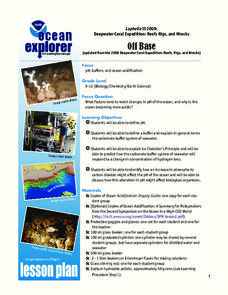Curated OER
Off Base
Students explain the Chatelier's Principle. In this pH lesson plan, students identify factors that resist changes in pH of the ocean and why the ocean is becoming more acidic.
Curated OER
Acids and Bases
In this acids and bases activity, students complete 32 fill in the blank and short answer questions on acidity or alkalinity. They color molecular diagram according to the key.
Curated OER
Acid Rain
Simulated acid rain, a dilute sulfuric acid solution, needs to be prepared for this demonstration. After a condensed lecture on acid rain, you will apply the solution to a sample of granite and a sample of limestone. Your young...
Curated OER
Other Aspects of Aqueous Equilibria
In this aqueous equilbria worksheet, students write the solubility product expressions for the given salts. Students determine what affects the solubility of salts. Students calculate the pH of a buffer solution. This worksheet has 14...
Curated OER
Chemical Reactions
In this chemical reactions worksheet, students determine if solutions are acidic, basic, or neutral. Students give reactions' molecular equations and ionic equations. This worksheet has 14 problems to solve.
Curated OER
Properties of Water
Biology and chemistry learners alike will benefit from this presentation about the properties of water. It reveals that most of its unique characteristics are due to the hydrogen bonding within the water molecule. Attractive graphics...
Curated OER
Off Base
Students study La Chatelier's principle and identify how carbon dioxide may affect pH. In this coral lesson students complete a worksheet on pH and observe a lab.
Curated OER
Acid/Base Equilibrium
In this equilibrium worksheet, students solve nine problems related to acids, bases, buffers, ionization and calculations of pH.
NOAA
Off Base
How does carbon dioxide affect the world's oceans? The final installment in a series of six lessons has pupils research ocean acidification, then conduct an experiment to witness the delicate balance that exists in our seas. Materials...
Curated OER
Acid Stomach
Young scholars develop an understanding of how aspirin works and how understanding it's interaction with other chemicals in the body aided doctors in medical research. They complete a lab that compares the reaction of regular aspirin...
Curated OER
Serial Dilutions Made Easy
Students improve their skills and comprehend the particular application for which serial dilutions are a tool. Serial dilutions are often used in microbiology, biotechnology, and in chemistry classes, to name just a few.
Curated OER
Acids and Bases
In this acid and base worksheet, students solve 11 problems including calculating pH of solutions, describing buffers, calculating solubilities of solutions and identifying acid-base pairs.
Curated OER
DNA Fingerprinting through a Chemistry Lens
Students explore DNA and restriction enzymes using fragments of DNA separated by electrophoresis on an agarose gel. They analyze the results to see "whodunit".
Curated OER
Molecular Evolution in Plants
High schoolers are using a paper chromatography study that is suitable for introductory biology. The absorption spectra studies and gel electrophoresis studies are appropriate for students who have complete both introductory biology and...
Curated OER
Calculating pH
In this pH worksheet, learners are given information and directions as to how to calculate the pH of solutions. They use their calculators to find the pH of given solutions and apply what they learned about identifying acids and bases.
Curated OER
Understanding Scientific and Social Implications: Acid Rain
Students examine the social and scientific implications of acid rain. In this acid rain lesson plan, students read an article about acid rain, the causes of acid rain, the effects of acid rain on the environment and the proposals to...
Virginia Department of Education
DNA Extraction from Strawberries
Has your class ever been astounded by the complexity of DNA analysis? Have they ever asked why genetic engineering has become so important to our daily lives? Young scientists perform DNA extraction on strawberries and explore how the...
Curated OER
Teaching Students How to Read the Protein Concentration in a Sample
Learners work together to identify proteins in different samples. They calculate the protein concentration in those samples as well. They complete discussion questions to end the lesson.
Curated OER
Acid Neutralization Lab
Learners discuss and design a lab to measure pH of limestone, pyrite, limestone-pyrite mixtures and their control. They have their labs approved by the instructor before they begin. Students preform the lab and explore the acid-base...
Curated OER
Identification of Animals by Serum Electrophoresis
Students compare their unknown serum against a set of known serum standards and determine the animal source of their serum. They write a lab report to communicate their results.
Curated OER
The Electric Sieve
Students examine different mixtures and how they can be separated. In this electric sieve instructional activity students complete an activity that allows them to separate mixtures.
Curated OER
Molecular Evolution in Plants
Students examine chlorophylls. They explore the absorbing pigments in a variety of plants. Through activities, students determine spectrophotometrically. They compare plant proteins from the family Brassicace to assess the level of...























